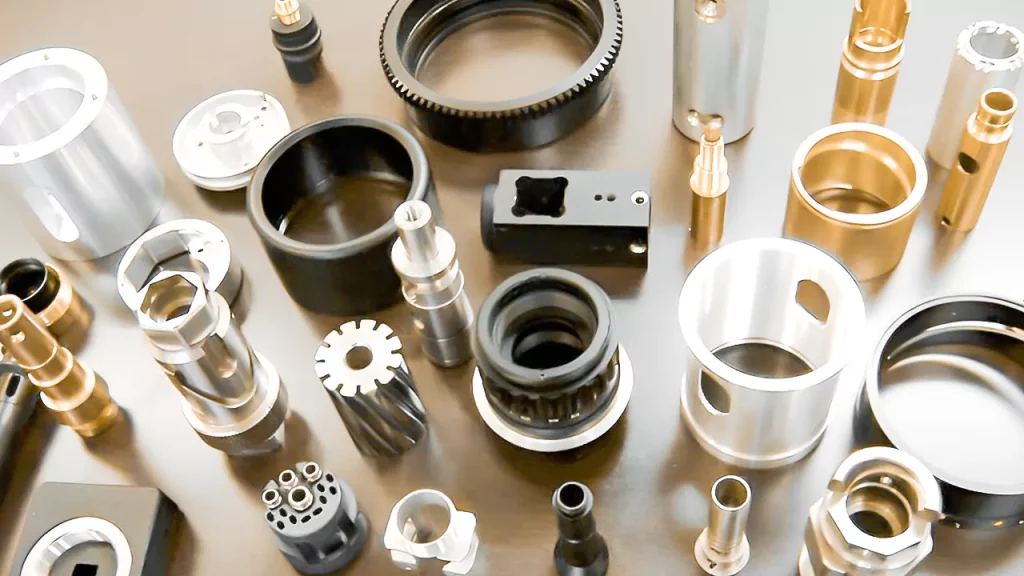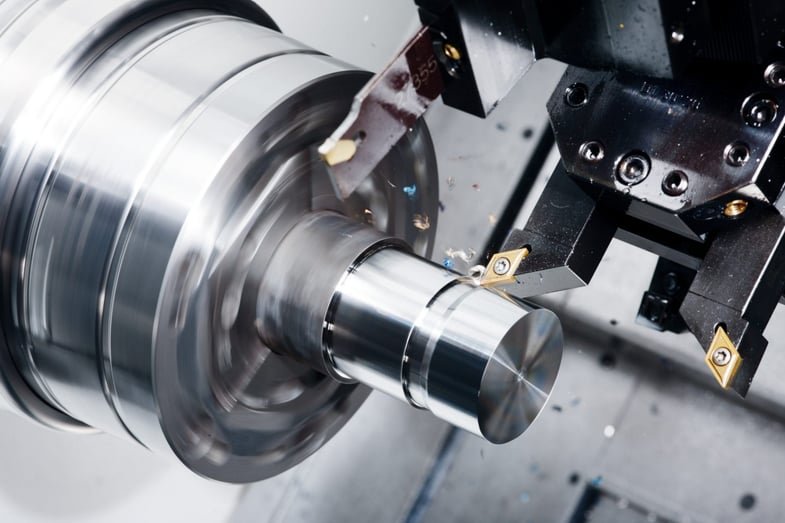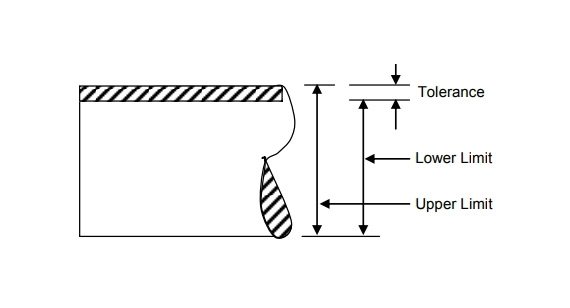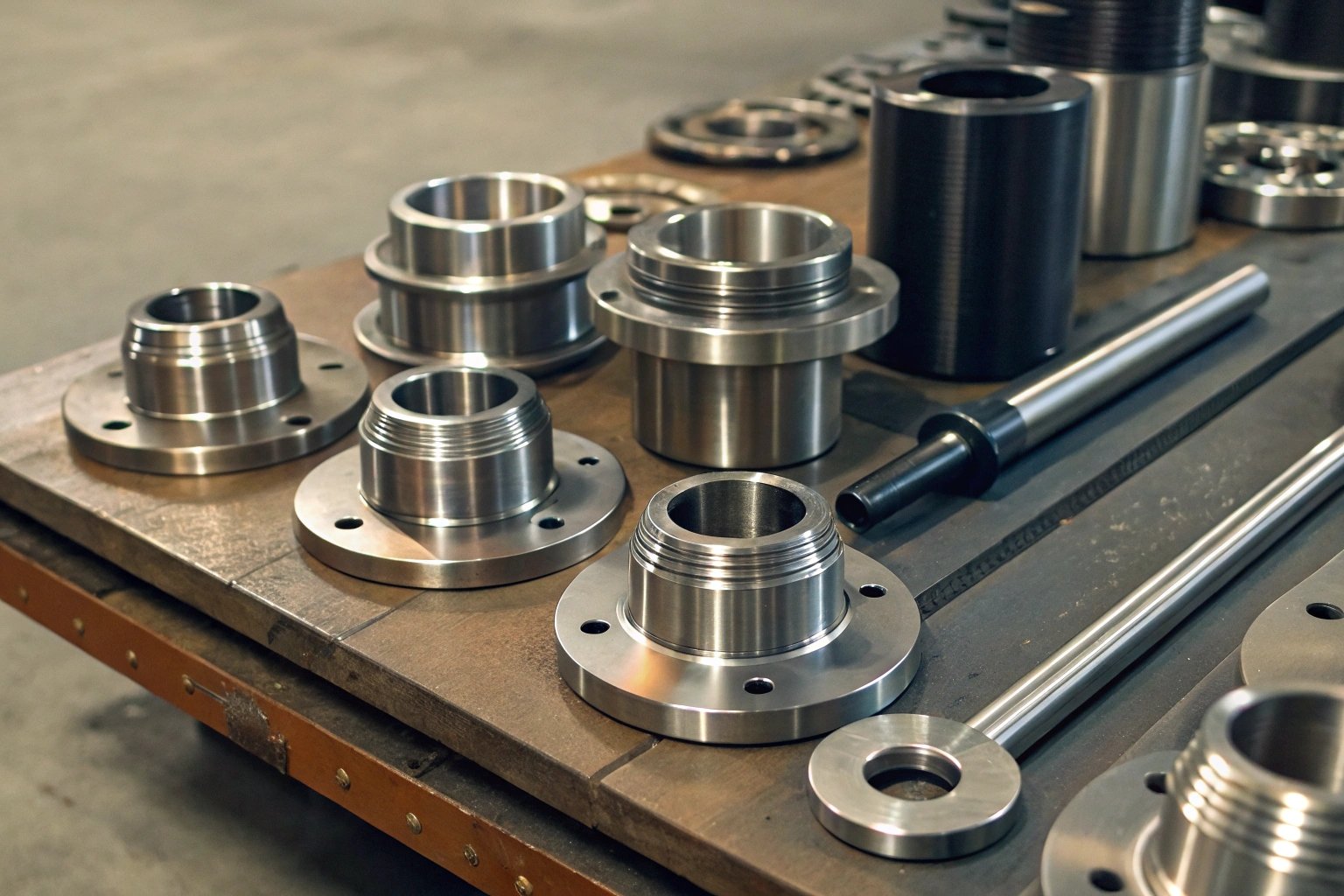CNC machining is a crucial manufacturing computer for the electronics sector because of its exactitude and skillfulness. CNC devices can work with conductive and non-conductive metals, as well as a combination of polymers.

One of the most significant benefits of technology is its quickness. Because there is no tooling stage before production, CNC machining can be utilized to make electronic components in a short amount of time, and the method does not suffer from the quality restrictions associated with additive manufacturing. Once toolpaths have been created by the computer and/or machinist, designs can be easily executed and altered using CAD software, with minimum manual operation necessary.
Application Of CNC On Consumer Electronics
For sophisticated interior components, many electronics manufacturers require precise tolerances, and CNC machining is frequently the best technology for addressing these needs.
Instances Of CNC Machined Electronic Parts
1. Electronics for consumers
The Apple MacBook and its several variations (MacBook Pro, MacBook Air) are among the most recognizable consumer electronics devices in the world, and the MacBook's sturdy aluminum body is created using CNC milling technology.

The body of an Apple MacBook is produced from a single extruded piece of aluminum, which is subsequently CNC machined to create keyboard holes and other shapes. "Apple has devised a completely new technique of producing notebooks from a single piece of metal," then-CEO Steve Jobs declared when the business first started employing this process in the late 2000s.
Apple is still the only business capable of CNC machining computers on such a large scale, which is unfortunate for its competitors. The computing behemoth is said to run 10,000 CNC machines, putting it out of reach for most other companies in the area. Other businesses, on the other hand, can employ CNC machines to produce electronic bodies and enclosures on a smaller scale.
2. Semiconductors
The MOSFET (metal-oxide-semiconductor field-effect transistor, or MOS transistor) is the most commonly manufactured device in human history, and semiconductor manufacturing is probably the backbone of the electronics industry.

Precision CNC machining equipment is frequently utilized by semiconductor producers because it can process semiconductor materials such as silicon and aluminum nitride. Wafer chucks, gas distribution plates, wafer carriers, solder pad stencils, and flex circuit stiffeners are all machinable semiconductor components.
Because semiconductors are frequently reduced down to very small sizes to fit into electrical devices, these parts must be fabricated to very tight tolerances.
3. Printed circuit boards
These are used in most electronic devices and serve to link up the various parts of the device, with wiring soldered to the appropriate area of the PCB. They comprise conductive tracks — usually created from copper — and a non-conductive core layer underneath.

Chemical etching, in which the PCB designer can cover up areas of the copper before submerging the board in an etching solution such as ferric chloride, is used to make the majority of PCBs. The solution removes the unprotected copper sections, leaving the desired network of channels in its place.
CNC machining can be a good alternative to etching for small-scale tasks, especially in locations where etching chemicals are potentially harmful. Machined boards can be created with CAD/CAM software and manufactured with a standard CNC milling machine.
4. Heat Sinks
Heat sinks are common electronic devices that transport heat from an electronic component to a liquid coolant or the atmosphere. Heat sinks are used in electronics like computers to keep key components cold so they can function properly.

CNC machining technology can be used to make heat sinks out of machinable metals like aluminum or copper. Precision CNC machines can fabricate even the tiniest heat sinks, and they can be made in a variety of configurations depending on the needs.
Machining is typically used to make highly complicated contours, cutouts, and other features for short production runs of heat sinks, and it can be used to make very complex contours, cutouts, and other characteristics. Heat sinks that have been machined have a high thermal conductivity.
5. Parts for Casings and Enclosures
Casings and enclosures are critical components of any electronic device because they keep all internal components in place and protect vulnerable bits from external threats like fluids, dirt, and bumps.
While die casting is the most widely used fabrication method, CNC machining is gaining popularity as a more reliable and precise alternative.
CNC machining, as opposed to dying casting or injection molding, allows for more detailed geometries, tighter tolerances, and greater build strength.
6. Connectors and Sockets
Electronic devices interact with other devices through the usage of sockets and connectors.
Electrical, electromagnetic, and optical signals can all be transmitted through a socket.
Sockets and connectors come in a variety of sizes, forms, and functions, and their manufacture necessitates exceedingly precise tolerances. A tiny fabrication fault causes the connection between devices to fail.
CNC machining facilitates product designers to compose intricate geometries that have a fast turnaround. Moreover, tooling expenses are economical, and prototypes can get modified conveniently via CAD/CAM software with CNC machining.
Sockets and connectors allow electronic devices to communicate with one another. Electrical, electromagnetic, and optical signals can all be transmitted through a socket.
Sockets and connectors come in a variety of sizes, forms, and functions, and their manufacture necessitates exceedingly precise tolerances. A tiny fabrication fault causes the connection between devices to fail.
How Has CNC Machining Extremely Impacted the Electronics Industry?
CNC machining is a production method in which industrial tools and complicated machinery activities are controlled by a pre-programmed computer program. For organizations of all sizes, CNC machining ensures the following quality parameters:
· Exceptionally Reliable
CNC machining also ensures great reliability, which means that electronics producers can use it for both small and large-scale production runs of electronic parts, as well as component prototyping.
· Manufacturing At A Ridiculous Speeds
CNC machining is capable of producing a wide selection of electrical components in a short amount of time. This benefit stems from the lack of a tooling stage before production and the lack of quality constraints associated with additive manufacturing.
Once the toolpaths have been specified by the computer or the machinist, designs may be easily iterated and updated using CAD software, which requires little to no manual labor.
· Exceptional Detail
CNC machining is a tempting production method for the electronics industry because of its accuracy and versatility. CNC machines can deal with a range of metals, including conductive and non-conductive metals, as well as polymers.
· Tolerances Are Too Strict
For complicated internal components, most electronics manufacturers demand precise tolerances. CNC machining's tight tolerances suggest that machined items are ready for use with little post-processing.
Why Are Electronics Manufacturers Using Aluminium and CNC Machining To Create Parts?
Many manufacturers all around the world use aluminum as a material of choice. It is the ideal solution for various applications due to its great machinability and other properties. Aluminum's mechanical performance is extremely intriguing. Furthermore, aluminum is rather easy to shape and may be easily drilled and machined. In comparison to other low-weight metal materials, aluminum alloy is employed more. Prototypes can also be made out of aluminum.
Aluminum, its grades, benefits, applications, and other characteristics that make it the finest choice will be discussed.
Modes:
1. Popular Aluminum Grade
Aluminum is a widely CNC machined material. Its applications are all across our daily lives. Aluminum exists in various categories and shapes that are used by many industries.
Aluminum is a material that is commonly CNC machined. It has multiple uses in our everyday lives. Aluminum comes in a variety of grades and shapes that are used in a variety of industries. These aluminum grades are used to make a variety of parts and products. The characteristics of some of the grades are listed below.
· 6061-T6
This grade of aluminum can be heat treated while retaining the majority of the benefits of aluminum. 6061 has a wide range of mechanical qualities as well as excellent corrosion resistance. In addition, 6061 has strong workability. Different techniques and methods can be used to construct and weld it. These properties make it the best choice for applications that require both beauty and corrosion resistance.
· 7075-T6
This aluminum grade offers a great strength-to-weight ratio. It's designed for high-stress situations. It's also the strongest aluminum grade on the market. In the annealed state, 7075 can be heat treated and shaped. It's also possible to spot and flash weld 7075.
· 2024-T3
The strength-to-weight ratio of 2024 is good. This is because this grade has both great strength and outstanding fatigue resistance. The most often used high-strength aluminum alloy is this grade of aluminum. This grade of aluminum can be finished to a high standard. The anodized finish is made of 2024, which has low corrosion resistance.
Advantages Of CNC-Machined Aluminum Components
1. Bends easily
Aluminum's primary property is its ability to bend. Aluminum is the ideal choice for CNC machining operations for this reason. It may be transformed into a variety of shapes throughout the machining process, unlike steel. Aluminum's thickness makes it ideal for a variety of molding techniques. By pressing and treating aluminum using CNC machining, you can create a unique structure.
2. Processing Is Simple.
When it comes to CNC machining materials, aluminum has several characteristics that set it apart. The same may be said about its machining abilities. Punching, drilling, folding, and other CNC machining techniques can be used to process aluminum. Aluminum may be molded into a variety of shapes and forms. When machining aluminum, it uses less energy than machining steel.
3. Resistance To Low Temperatures
Steel parts, especially during welding, can be fragile in low-temperature conditions. Low-temperature resistance is a feature of aluminum materials. When opposed to steel, it can be easily machined at low temperatures.
How Many Different Surface Finishes Are Available For CNC Machined Aluminum Parts?
Several post-finishing procedures can be used to personalize aluminum CNC machined parts. It can also be used to plate parts with various colors to suit your needs. Let's take a look at some of the most prevalent surface finishing options for aluminum CNC parts.
· Anodizing
This method coats machined aluminum items with an extra layer of protective film. It's a method of electrochemistry. A durable anodic oxide coating is generated on the surface of aluminum items during this process. This method can be used to anodize a variety of aluminum alloys.
· Blasting with sand
Sandblasting improves the adherence of the metal item to the coating and extends the coating's life. It also makes aluminum machined parts more fatigue resistant. After sandblasting, the mechanical qualities of aluminum parts' surfaces improve.
· Coatings in Powder
This method produces a film that satisfies the most stringent performance requirements. It's also available in a wide range of hues and is quite long-lasting. UV light, harsh weather, moisture, chemicals, and hard impacts are all resistant to powder coatings.
How Is The Use Of Materials In The Electronic Industry Changing With The Use Of CNC Machining?
CNC machining, in general, is a subtractive manufacturing technique that has been pre-programmed. By cutting material and establishing a precise shape, this technique creates items.
Despite its extensive history, CNC machining is now one of the most revolutionary technologies in the manufacturing industry. It is computerized, and as a result, it is more efficient than additive or formative manufacturing methods. Prototyping and subsequent manufacture of bespoke machined parts are common applications for the technique.
Materials CNC Machining
For object creation, CNC machining services like our company use a variety of materials. The materials you select have a tremendous impact on the design process. The material's hardness, temperature and chemical resistance, and strength must all be considered. Metal and plastic are the most frequent materials.
· Metal
Metal parts are the most used industrial material because of their resistance and strength. Metal is more adaptable and robust than plastic, and it can be used for everything from developing specialized pieces to mass production. Aluminum is the most commonly utilized metal due to its lightweight and durability. It also outperforms other metals in terms of electrical and thermal conductivity.
· Plastic Components
Plastic can be an excellent alternative for a variety of manufacturing processes. It offers the benefits of being light, electrically insulating, and having a high resistance. However, owing to the cheaper costs and the fact that the element is not as durable, it is primarily utilized for prototyping. ABS, polycarbonate, and nylon are the most often used plastics.
Is Aluminium CNC Machining the Future for Growth In the Electronics Industry?
Smart machining, networked factories, additive manufacturing, and "lights-out" were formerly fashionable buzzwords. They are currently being used in enterprises of all shapes and sizes to portray their genuine meaning. Our production sites, like the rest of the world, have gone digital. Today's CNC machine tools are complicated and, above all, still automated. MRP (Manufacturing Resource Planning) systems and integrated measuring probes are also used with many CNC machine machines.
When a large number of CNC machines are linked together, however, further caution is required. The danger of a communication failure in the integrated solution exists at all times. This might be a highly expensive problem, with the potential to shut down manufacturing lines. It can also result in poor quality and the plant's spare capacity being sacrificed. The good news is that solutions are in the works, which necessitates stronger collaboration between software providers, machine tool designers, and robot manufacturers.
We can fix problems sooner with an IIoT solution, preventing them from arising at a more vital stage of the job. Furthermore, these alliances will provide subcontractors with more options in terms of integrated solutions that improve dependability and performance, allowing them to create the ideal package.
The Future Of CNC Machining
A company's ability to stay competitive and acquire new items might be aided by advanced CNC technology. Furthermore, modern CNC machines save prices and work with an ever-expanding range of materials. However, progress will not be halted there. Machine builders are always challenging the existing quo in terms of performance. The Our company movement aids in breaking through these barriers.
Our company is a more advanced production system that includes IIoT (Industrial Internet of Things), which monitors and measures manufacturing processes and reacts autonomously when something goes wrong. This capability enables CNC machines to self-diagnose problems and repair faults in the production process more quickly than employees can notice and respond to errors or diagnose the cause of machine malfunction.
The use of detection and processing technology, as well as CNC manufacturing methods, may necessitate the dismissal of valuable employees. It could be the other way around, depending on the facts of each company's position. People will be required to program and monitor our systems. Despite the technical nature of the equipment, its management does not typically necessitate the use of employees with advanced IT degrees. When the Industry 4.0 configuration is deployed, current employees can often be pre-trained and ready to go on to other responsibilities in the company.
The medical products business, for example, expects excellence in manufacturing procedures since life depends on fail-safe components. CNC machines and Industry 4.0 technology work together to produce high-quality medical device components. Regardless of the industry a manufacturer serves, CNC and CAM (Computer-Aided Manufacturing) equipment are a combo that creates high-quality, perfect items at a large profit.
CNC machining advancements are continuing to make the seemingly impossible attainable. Precision CNC machining is one of the most rapidly growing industries on the planet. So, where does the industry go from here? For the time being, the future of CNC machining appears to be focused on the synchronization of several machines, which greatly improves the efficiency and capabilities of prototypes in product manufacturing facilities.
Conclusion
In today's society, implementing digitization is critical to success. It not only distinguishes your firm from competitors but also speeds up corporate operations and employee performance. So, figure out what works best for your business by reaching out to us and using CNC machining to take your manufacturing operations to the next level.









